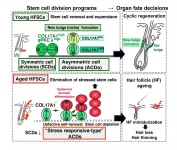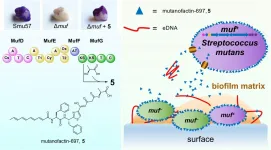(Press-News.org) New findings on the diet of Arctic foxes, determined by the condition of their teeth, show how varying climate conditions in the Arctic affect the animals that live there.
In a study published in Polar Biology, Peter Ungar, Distinguished Professor of anthropology at the University of Arkansas, and several co-authors analyzed tooth breakage and wear - both gross and micro - of Arctic foxes from Russia's Yamal Peninsula.
Studying the effect of varying climate conditions within this region helps scientists understand the impact of climate change on vulnerable animals and could explain future responses and adaptation, given the warming trend and thawing in Arctic areas. The researchers' study is the first to combine dental proxies for short-term, or seasonal, and long-term, or lifetime, diet to better understand how resource depletion affects species differently in different locations within the Arctic.
In this study, the researchers compared the condition of the teeth over space - northern versus southern peninsula - and time and found that foxes from the northern peninsula likely had to periodically rely on larger prey rather than their preferred prey of rodents such as lemmings and voles.
Microwear analysis of teeth indicated the foxes in both locations dined on the preferred smaller prey during rodent "rich" years. However, during rodent "bust" years in the southern peninsula, the foxes had to adapt to conditions and fall back on larger prey, such as ptarmigans and hares. In the north, where these species were less available, foxes evidently scavenged more reindeer carcasses.
Bone consumption by animals causes tooth breakage, heavy wear and microscopic pitting. Breakage and gross wear reflect animal diet over the course of a lifetime, whereas microscopic pitting reflects a pattern of seasonal changes over time. Ungar is a leading expert in dental microwear analysis, including what it says about animals' diet as it relates to evolution.
"These data together suggest that dental evidence can provide important insights into variation in the feeding ecology of Arctic foxes and potentially into the impacts of changes in food abundance across space and time," Ungar said.
The Arctic fox is listed as a climate change flagship species by the International Union for Conservation of Nature.
The researchers, including colleagues from the United States, Russia, Norway and France, examined 78 Arctic fox specimens, all caught by indigenous trappers on Yamal for the purpose of harvesting fur. Preliminary analysis focused on three trapping periods - December 1981 to March 1982, November 1983 to March 1984 and October 2007 to March 2008. The foxes were selected from the northern and southern Yamal regions during the rodent-poor periods of 1981-1982 and 2007-2008 and rodent-rich period of 1983-1984.
"Time or space alone is not enough to get the full story of fox ecological response to environmental variation," Ungar said. "Combining these proxies for understanding life in the past is essential to inform us on the ecology of living animals in a rapidly changing and fragile ecosystem."
The researchers' study is part of a large, multi-year project focused on the Yamal Peninsula, which serves as a small-scale and manageable research model for the Arctic as a whole. Habitats of the Yamal region, roughly 1,400 miles northeast of Moscow, range from forest in the south to tundra in the north. The Yamal has a rich diversity of native and invasive plant and animal species, a large indigenous population with strong traditional culture, and economically critical natural resources. As part of this project, Ungar and his colleagues are studying how climate change - specifically warming and extreme weather - has affected the temperature, precipitation and landforms in the region, and how people, animals and plants have adapted to these changes.
INFORMATION:
Ungar's co-authors are Alexandria Peterson, graduate student in the U of A's Environmental Dynamics program; Blaire Van Valkenburgh at the University of California, Los Angeles; Dorothee Ehrich from the Arctic University of Norway; Olivier Gilg from the Groupe de Recherche en Écologie Arctique in France; and Aleksandr Sokolov, Natalia Sokolova, Ivan Fufachev, Alexandra Terekhina, Alexander Volkovitskiy and Viktor Shtro from the Arctic Research Station, Institute of Plant and Animal Ecology of the Ural Branch of the Russian Academy of Sciences.
This project was made possible through funding from the National Science Foundation's Navigating the New Arctic initiative, one of NSF's 10 Big Ideas.
Ungar is director of the Environmental Dynamics program at the University of Arkansas.
When it comes to electric vehicles, particularly for heavy-duty trucks, the limitations of battery technology are often seen as the main barrier to widespread adoption. However, a new analysis concludes that it's the lack of appropriate policies around adoption incentives, charging infrastructure, and electricity pricing that prevents widespread electrification of commercial trucking fleets.
Researchers from the Department of Energy's Lawrence Berkeley National Laboratory (Berkeley Lab) and the University of California, Los Angeles published a new study that makes the case for prioritizing public policy to help move long-haul trucking from diesel to electric. Doing so will mean huge gains in addressing the ...
Kanazawa, Japan -- Any visitor to China will have noticed the spectacular roofs on buildings dating from imperial times. However, the question of how these roof tiles were produced has attracted relatively little attention from archaeologists. Now, a team of researchers has conducted a major study of tile ends unearthed at the Ximing Temple in Xi'an, yielding exciting insights into their production.
In a study published in Archaeological Research in Asia, researchers from Kanazawa University and the Chinese Academy of Social Sciences have revealed the significance of minute variations in the tile ends used in the roof of the famous Ximing Temple in Xi'an, built during the ...
Researchers from Tokyo Medical and Dental University (TMDU) identify a novel mechanism underlying hair thinning and loss during aging
Tokyo, Japan - Hair grows from stem cells residing in hair follicles. During aging, the capability of hair follicles to grow hair is successively lost, leading to hair thinning and ultimately hair loss. In a new study, researchers from Tokyo Medical and Dental University (TMDU) and the University of Tokyo identified a novel mechanism by which hair follicles lose their regenerative capabilities.
Hair follicles are mini-organs from which new hair constantly grows. The basis for new hair growth is the proper function of hair follicle stem cells (HFSCs). HFSCs undergo cyclic symmetric and asymmetric cell divisions ...
A genetic defect could hold the key to preventing or delaying the onset of a debilitating eye disease that can lead to vision loss and blindness.
MacTel (macular telangiectasia type 2) affects one in 1,000 Australians. Symptoms include slow loss of vision, distorted vision and trouble reading. Because early signs of the disorder are subtle, it is difficult to diagnose.
Researchers have identified an additional seven regions in the human genome that increase the risk of developing the condition, including a rare DNA mutation in the PHGDH gene, which will help clinicians to better diagnose and treat ...
Nanograined metals and alloys, whose grain size is less than 100 nm, exhibit extremely high strength and high ductility, possessing excellent mechanical properties. Nanograined materials, however, have a large number of grain boundaries and hence high total grain boundary energy. At a temperature higher than a critical temperature, grains in nanograined materials will grow spontaneously to reduce the grain boundary energy, leading to thermal instability of the materials. A common approach to enhance the thermal stability is via grain boundary energy segregation, which thermodynamically lowers the grain boundary energy and kinetically pins ...
An inter-disciplinary team of researchers led by Prof. Qian Peiyuan, Chair Professor at the Hong Kong University of Science and Technology (HKUST)'s Department of Ocean Science and Division of Life Science has unraveled how a novel microbial small molecule released by Streptococcus mutans (S. mutans) - a bacterium commonly found in the human oral cavity - is connected to dental caries development using a synthetic biology approach, offering new insights to the health impact of the human oral microbiota and facilitating future research on the prevention of tooth decay. The research findings were recently published in the prestigious scientific journal Nature Chemical Biology and reported by Nature as one of the research highlights.
Every wetted surface on our ...
The Three Gorges project, completed in 2009, is one of the world's largest hydropower projects. It has brought important social and economic benefits in flood control, power generation, shipping and water resources redistribution.
But how does such a large-scale water conservancy project affect the local climate, and is the response to climate change a relatively vulnerable one? The Three Gorges Project has been repeated questioned, especially whenever rainstorms, floods and drought hit the area around the reservoir area or its neighboring areas, since ...
Following a relocation of ice cores to the Copenhagen suburb of Rødovre in 2017, University of Copenhagen researchers found unopened boxes of ice cores dating back to 1966--the first ice cores drilled on Earth.
Analyses of the long-forgotten ice have now been completed and are presented in a new study with groundbreaking results.
Within the cores, which come from deep within the ice sheet at Camp Century, Greenland, the UCPH researchers and their Belgian and American colleagues became the first ever to find these millions of years old macrofossils.
The fossils are large enough to be seen without a microscope.
"We pinched ourselves over the treasure we'd found! Because within the cores, ...
Sugar is added to many common foodstuffs, and people in Switzerland consume more than 100 grams of it every day. The high calorie content of sugar causes excessive weight and obesity, and the associated diseases. But does too much sugar have any other harmful effects if consumed regularly? And if so, which sugars in particular?
Even moderate amounts of sugar increase fat synthesis
Researchers at the University of Zurich (UZH) and the University Hospital Zurich (USZ) have been investigating these questions. Compared to previous studies, which mainly examined the consumption ...
BUFFALO, N.Y. - Nearly every older adult was prescribed a prescription drug that increased their risk of falling in 2017, according to new University at Buffalo research.
The study found that the percentage of adults 65 and older who were prescribed a fall- risk-increasing drug climbed to 94% in 2017, a significant leap from 57% in 1999. The research also revealed that the rate of death caused by falls in older adults more than doubled during the same time period.
Even minor falls may be dangerous for older adults. Falls that are not fatal can still result in injuries - such as hip fractures and head traumas - that may drastically lower remaining quality of life. Each year, nearly $50 billion is spent on medical costs related to fall injuries ...





